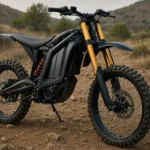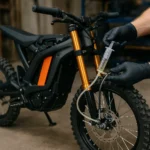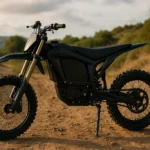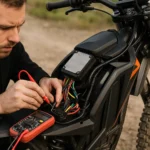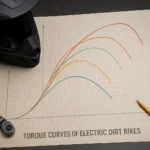Curious about the Honda CRF E2 top speed? You’re not alone. Whether you’re a parent trying to gauge if this electric dirt bike is fast enough for your kid, or a young rider eager to know how hard it can rip, this guide breaks it all down. No fluff, just facts.
The Honda CRF E2 is making waves as one of the most accessible beginner electric motocross bikes out there — and yeah, its top speed is a big part of the conversation. We’re diving into real-world performance, what influences its speed, how it compares with rivals, and whether it delivers the thrill you’re hoping for. ⚡
This isn’t just another spec-sheet summary. We’re pulling data, rider insights, and expert breakdowns so you get the full story behind the Honda CRF E2 top speed. From riding modes to battery output, everything plays a role in just how fast this little beast can go. And trust us, there’s more to the story than just “28 mph.”
🔗 Related: Check out the fastest electric dirt bikes in the game!
Key Takeaways
- The Honda CRF E2 top speed is officially rated at around 45 km/h (or ~28 mph), ideal for new riders.
- It’s speed-limited intentionally to keep things safe and beginner-friendly.
- Things like rider weight, terrain, battery condition, and wind resistance all play a role in its top-end speed.
- Compared to similar youth electric dirt bikes, the CRF E2 holds its ground — and in some cases, outruns expectations.
- This guide answers the most-searched questions and even uncovers a few myths around electric dirt bike speed performance.
⚡ What you’ll find in this guide: Use the quick links below to jump to the section you’re most curious about 👇
How Fast Is the Honda CRF E2, Really?
Alright, let’s get to the good stuff — how fast does the Honda CRF E2 actually go when the rubber hits the dirt?
On paper, the Honda CRF E2 top speed is listed at around 45 km/h, which clocks in at roughly 28 mph. That’s not going to break land speed records, but remember — this bike isn’t built for pro-level motocross beasts. It’s engineered for beginners, especially younger riders just getting into the electric dirt scene.
What sets it apart is how consistently it hits that speed. While some bikes overpromise and underdeliver, the CRF E2 has been praised for delivering predictable and stable top-end performance — even on light trails and uneven terrain.
Factory Claimed Top Speed
Honda officially states the top speed is 28 mph, and that’s with the full power mode engaged. There’s also a lower-speed beginner mode (for riders still learning the ropes), which keeps things extra safe.
In both modes, the Honda CRF E2 top speed is electronically limited. This isn’t a flaw — it’s a feature. Honda knows who’s riding this thing and made safety a top priority.
Real-World Speed Tests
Riders and parents in the community report that the bike does hit that 28 mph mark — sometimes even a tad more when going downhill or with lighter riders. But what really matters is the smooth power delivery and how it makes the speed feel stable and controlled.
Want more high-speed options beyond the CRF E2? You might want to check out the fastest electric dirt bikes for a full comparison chart.
Can It Go Faster?
Technically, sure — some have tried unlocking the controller or tweaking gear ratios. But this can void warranties, reduce battery life, and possibly break local laws 🛑. It’s not something we’d recommend, especially if this is a first bike.
If speed is your main priority and you’ve already outgrown the CRF E2, don’t worry — there are faster rides out there. And we’ve listed them all in our guide to the fastest electric dirt bikes.
But as far as entry-level electric motocross bikes go, the Honda CRF E2 top speed is exactly where it should be: fast enough to thrill, safe enough to trust.
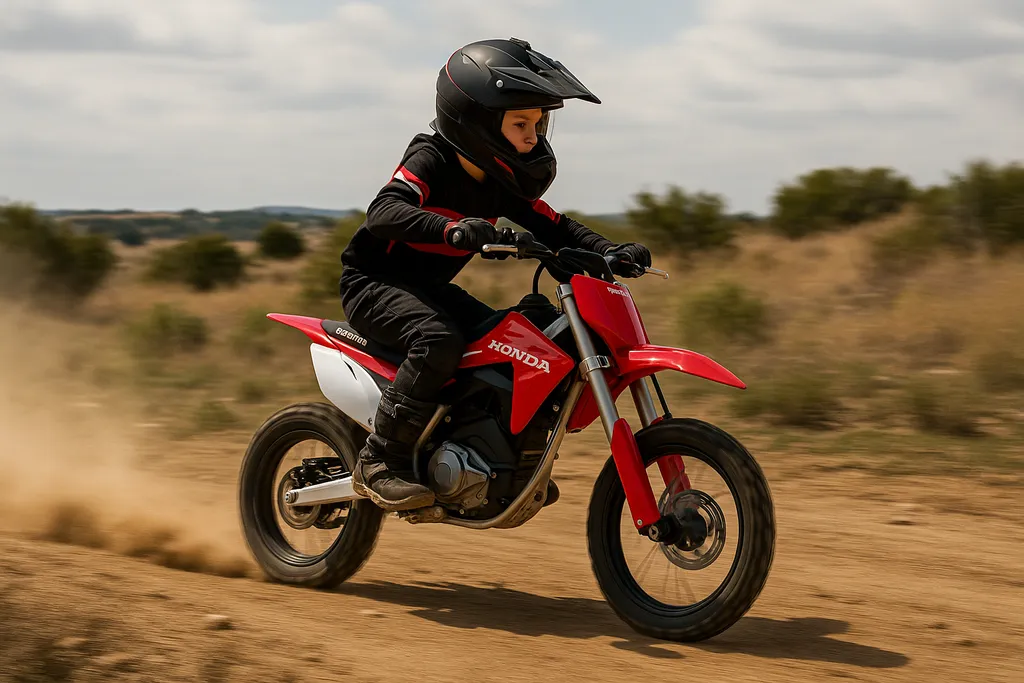
5 Key Factors That Impact the CRF E2’s Top Speed
The Honda CRF E2 top speed isn’t just a fixed number on a spec sheet. A bunch of real-world variables can influence how fast it actually feels and performs. Let’s break down the five biggest ones that affect how this electric dirt bike moves when you’re out on the trail.
1. Rider Weight and Size
Yep, physics always wins. A lighter rider will generally get closer to the claimed Honda CRF E2 top speed, while heavier riders might notice a slight drop in acceleration and overall velocity. This is especially true on uphill terrain or soft dirt.
2. Battery Charge Level
The CRF E2 runs on a swappable 48V lithium-ion battery. While it maintains pretty consistent performance, top speed can dip a bit when the battery is running low. A full charge ensures the motor is delivering peak output.
3. Terrain Type
Paved driveway? You’ll probably hit that 28 mph. Loose gravel or muddy trails? Expect a slower ride. Traction plays a major role in how well the motor can deliver power, which in turn affects the Honda CRF E2 top speed.
4. Wind and Weather Conditions
You might not feel it much, but wind resistance can slow things down, especially on smaller bikes like the CRF E2. A strong headwind can shave off a few mph, while tailwinds can help it go slightly faster.
5. Riding Mode Selection
The bike features at least two riding modes: beginner and full power. Only in full power mode will riders unlock the full Honda CRF E2 top speed. Beginners might want to stick to the lower setting until they build confidence, but the full mode is where the fun really kicks in 🚀.
Every one of these factors plays a role in how fast this electric dirt bike will go — and more importantly, how it feels to ride. Understanding them helps manage expectations and gets the most out of your ride.
How It Compares: CRF E2 vs Other Electric Dirt Bikes
Wondering how the Honda CRF E2 top speed stacks up against the competition? Good question — especially if you’re trying to figure out whether it’s the right choice for your young rider or if there’s a faster option out there.
Let’s put it side by side with a few other popular electric dirt bikes in the same beginner category.
Speed Comparison Chart
| Electric Dirt Bike | Top Speed (mph) | Target Age Group |
|---|---|---|
| Honda CRF E2 | 28 | 8–12 years |
| Kuberg Cross Hero | 34 | 9–14 years |
| OSET 20.0 Racing | 30 | 8–12 years |
| Razor MX650 | 17 | 10+ years |
As you can see, the Honda CRF E2 top speed puts it right in the mix — not the fastest, but absolutely competitive. It beats out the Razor MX650 and runs close with OSET. The Kuberg Cross Hero pulls ahead in speed but comes with a higher price tag and a steeper learning curve.
Top speed isn’t everything, especially when safety, handling, and build quality come into play. But in terms of pure numbers, the CRF E2 holds its own.
It’s also worth noting that the CRF E2 is backed by Honda’s reputation, which adds a solid layer of reliability for parents and peace of mind for riders.
Choosing a bike isn’t just about how fast it goes — but it definitely helps to know where it stands in the pack. And based on the data, the Honda CRF E2 top speed makes it a worthy contender for young dirt bike fans ready to hit the trails.
Performance vs. Safety: Why Honda Capped the Speed
When looking at the Honda CRF E2 top speed, it’s easy to wonder: why didn’t Honda make it faster? The answer comes down to one thing — safety.
This bike is built for young, entry-level riders. We’re talking about kids who are just learning throttle control, balance, and trail awareness. For them, too much speed too soon can mean crashes, injuries, and bad experiences. Honda knows this, and that’s exactly why the CRF E2 is electronically limited to around 28 mph.
By capping the Honda CRF E2 top speed, Honda ensures the bike remains approachable and confidence-inspiring. Instead of throwing beginners onto a rocket, it gives them a chance to develop skills progressively — which is way more fun in the long run.
Another factor is legal compliance. Many local trails, parks, and backyard tracks have regulations that cap how fast youth bikes can go. A speed-limited bike is more likely to stay within those rules — and out of trouble.
Also, let’s not forget the parents. When buying a bike for their kids, top speed matters, but so does peace of mind. Knowing the CRF E2 won’t suddenly take off like a bat out of hell is reassuring.
So yeah, the Honda CRF E2 top speed might not be the fastest in the segment — but it’s one of the smartest. It strikes a solid balance between thrill and control, which is exactly what you want when the rider’s still learning the ropes.
The Build Behind the Speed: Specs That Matter
To understand the Honda CRF E2 top speed, you’ve got to look under the plastics. This isn’t just about numbers — it’s about engineering. The way the bike is built plays a massive role in how fast it can go and how it performs under different conditions.
Honda’s CRF‑E2 has also been reviewed by Motorcyclist Magazine, which highlights its officially licensed status and strong performance as a youth electric dirt bike. It’s a solid option for beginners who want reliability without sacrificing fun.
Powertrain
The CRF E2 is powered by a 1.2kW continuous output motor, with a peak output of 2.5kW. That might not sound massive compared to adult electric dirt bikes, but for a youth model, it’s solid. That electric motor gives the bike enough torque to reach and maintain its 28 mph top speed consistently, especially on flat terrain.
The motor is brushless, which means less maintenance, smoother acceleration, and more efficiency — all of which contribute to keeping the Honda CRF E2 top speed steady and reliable across different rides.
Battery System
This bike runs on a 48V swappable lithium-ion battery. Not only is it compact and lightweight, but it also offers decent range and steady power delivery. A strong, well-managed battery system is essential for maintaining peak performance, especially when pushing for top speed.
It takes roughly 2.5 hours to charge fully and can be swapped out for a fresh pack in seconds — so riders can keep going with almost no downtime ⚡
Transmission and Gearing
The CRF E2 uses a single-speed automatic transmission. There’s no clutch, no gears to shift — just twist the throttle and go. This simplicity is great for beginners and ensures that all the motor’s power goes straight to the wheel.
While that means no extra gearing to push the Honda CRF E2 top speed higher, it also means a smoother, more predictable ride. For young riders, that predictability is a big win.
Put it all together, and you’ve got a bike that’s smartly designed for performance without sacrificing safety or ease of use. The motor, battery, and transmission all work in sync to deliver a top speed that feels just right for its target audience.
Real Rider Reviews: Is the Speed Enough?
So, how does the Honda CRF E2 top speed feel when the tires hit the trail? We dug into feedback from real riders, parents, and first-timers to see if that 28 mph cap is fast enough for fun — or too slow for thrill-seekers.
Turns out, most young riders think it’s just right. For kids moving up from smaller bikes like the Razor MX350 or MX500, the CRF E2 feels like a serious upgrade. The acceleration is smooth but punchy, and once it reaches full speed, it holds steady — even over dirt, gravel, and light hills.
One parent said, “It’s fast enough that my kid gets excited, but not so fast that I’m panicking every time he twists the throttle.” That kind of confidence is exactly what this bike is designed to inspire.
More experienced youth riders do say they start wishing for a bit more top-end once they get comfortable. But again — for a first electric motocross bike, that’s a sign of growing into the sport, not outgrowing the bike too quickly.
Many riders also highlight the solid build quality and how planted the bike feels at full speed. No sketchy wobble, no sudden power surges — just clean, controllable movement. That makes the Honda CRF E2 top speed feel even more satisfying, especially when kids are learning body control and balance.
Bottom line? For the age group it targets, the CRF E2’s speed hits the sweet spot. It delivers excitement without overwhelming the rider — and that’s a win in any parent’s book.
Best Use Cases: Where the CRF E2 Feels Fastest
The Honda CRF E2 top speed might be 28 mph on paper, but where you ride it can make it feel a whole lot faster — or slower. This bike is built for specific environments, and when used right, it totally shines. Let’s look at where this little beast performs best.
Backyard Tracks
If you’ve got a backyard with even a basic dirt loop, the CRF E2 turns it into a playground. Short straights and tight turns make the 28 mph top speed feel more intense — especially when the rider is still learning throttle control. It’s quick, zippy, and doesn’t need a massive area to be fun.
Closed Motocross Training Zones
Many youth motocross academies or local training grounds allow electric bikes like the CRF E2. These spaces are safe, supervised, and usually have terrain that challenges the rider without pushing the bike beyond its limits. In this environment, the Honda CRF E2 top speed is more than enough for practice and learning.
Light Trail Riding
Open forest trails or farm tracks? Perfect. As long as you’re not dealing with heavy mud, big rocks, or steep climbs, the CRF E2 handles trail rides like a champ. Its silent motor means riders can enjoy nature while still getting a taste of speed.
Pavement and Hard Pack
On paved driveways or hard-packed dirt, the bike reaches and maintains top speed effortlessly. These surfaces reduce resistance, letting the motor do its thing. It’s here that the Honda CRF E2 top speed feels most “real,” hitting full velocity without much struggle.
Bottom line: pick the right terrain, and the CRF E2 becomes a speed machine for beginners. It’s not built for extreme jumps or rough enduro trails — but for learning, improving, and having a blast? It’s spot on.
FAQs: Honda CRF E2 Top Speed
Got questions about the Honda CRF E2 top speed? You’re definitely not alone. These are some of the most common things people are searching for — and we’re here to clear things up fast.
Is 28 mph the real top speed or just what’s advertised?
It’s both. Honda officially lists the CRF E2 at around 45 km/h (28 mph), and real-world rider feedback confirms it hits that mark — especially on flat, hard-packed ground with a full battery.
Can you remove the speed limiter?
Technically, yes — but it’s not recommended. Modding the bike to push past its built-in speed cap can void warranties, shorten battery life, and may break local laws depending on where you ride. The Honda CRF E2 top speed is capped for good reasons: safety, reliability, and regulatory compliance.
Does terrain affect how fast it goes?
Absolutely. Rough trails, hills, and loose surfaces like sand or gravel can all reduce top speed. On smooth pavement or compact dirt, the bike performs at its best and feels much faster.
Is it faster than the Razor MX650?
Yes, by a solid margin. The Razor MX650 tops out around 17 mph, while the Honda CRF E2 top speed hits 28 mph. Plus, the CRF has better torque, handling, and build quality across the board.
Does battery level affect speed?
It can. When the battery drops below a certain charge, performance can dip slightly. While the CRF E2 is designed to maintain consistent output, like most electric bikes, it runs best at or near a full charge.
Is the CRF E2 good for racing?
For beginner-level racing or motocross practice, definitely. It’s not built for competitive high-speed racing, but for youth events, it’s a solid contender with reliable top-end performance.
These questions show just how much riders — and parents — care about performance. And when it comes to electric dirt bikes for beginners, the Honda CRF E2 top speed keeps showing up as one of the most well-balanced in its class.
Final Thoughts: Is the Honda CRF E2’s Speed a Dealbreaker?
Let’s wrap it up. If you’ve made it this far, you’re clearly serious about figuring out whether the Honda CRF E2 top speed is good enough for your needs — or your kid’s next big adventure.
Here’s the truth: while 28 mph might not sound earth-shattering on paper, it’s plenty for young riders and beginners. This bike isn’t trying to be the fastest on the planet — it’s trying to be the most dependable, safe, and fun way to get into the world of motocross.
And it nails that mission.
The balance of power, ease of use, and reliable speed make the CRF E2 a smart pick for anyone just starting out. It’s got enough zip to feel exciting, but not so much that it becomes risky or unmanageable. That’s a rare combo in the electric dirt bike scene.
For those who’ve already outgrown the entry-level vibe and want to push the limits? No worries — we’ve got you covered with a full breakdown of the fastest electric dirt bikes.
But if what you need is a solid, beginner-friendly ride that can still bring a grin at full throttle, the Honda CRF E2 top speed delivers — every single time.
Join the Conversation: What Do You Think?
We’ve laid out everything there is to know about the Honda CRF E2 top speed, but now it’s your turn. Have you ridden one? Does the speed live up to your expectations? Got a young rider at home who thinks it’s the fastest thing on two wheels? 😄
Drop your thoughts, stories, or even your favorite mods (if you’ve dared to tweak it) in the comments below. We love hearing from the community — especially when it’s about real experiences on the trail.
And hey, if you found this guide helpful, share it with a fellow dirt bike parent or young shredder looking for their first electric ride. Let’s keep the stoke high and the questions coming. 🤘
The Honda CRF E2 top speed might be capped, but the fun sure isn’t. 🏁

Tyler Brooks is the storyteller behind most of the content at Electric Dirt Zone. With over 10 years of experience in digital media and a lifelong love for off-road riding, he blends technical insight from the team with engaging, down-to-earth writing. When he’s not turning dusty trail rides into blog posts, you’ll probably find him snapping pics before things get too wild.


